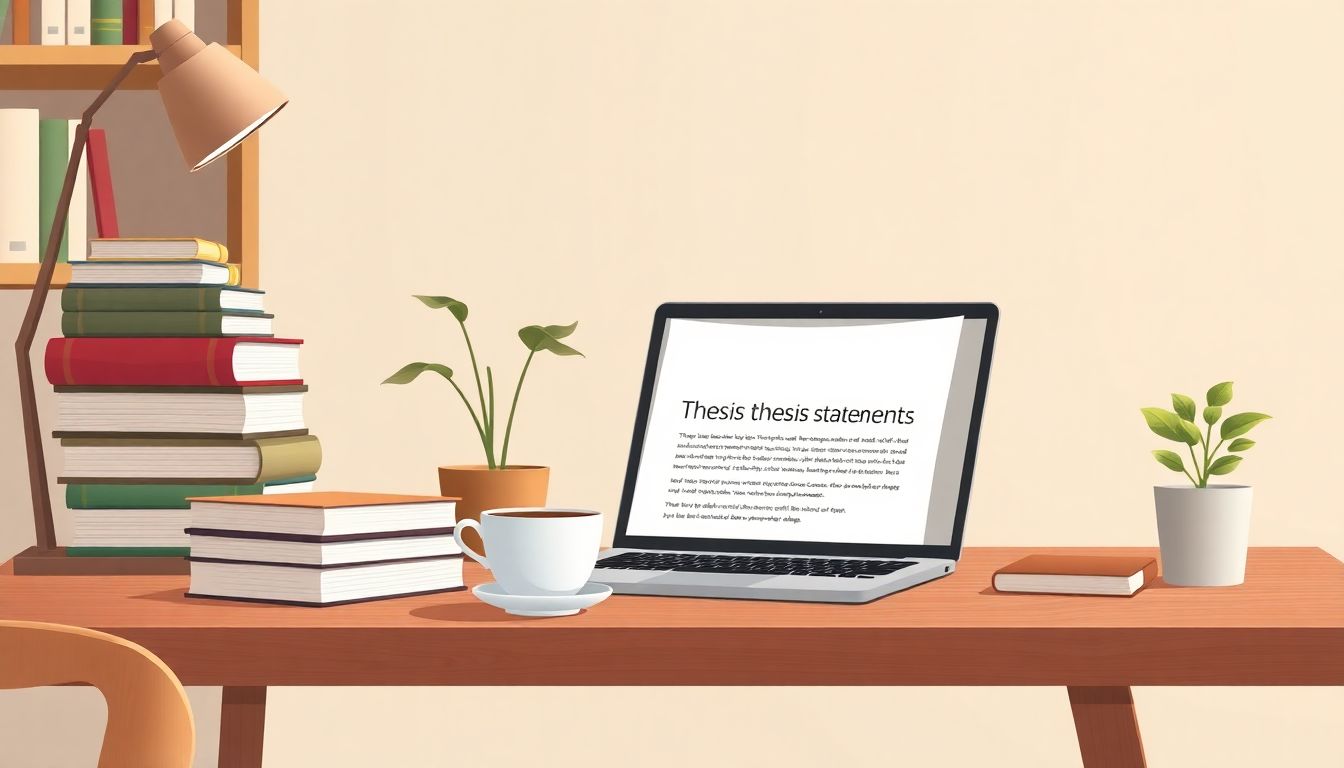Developing a strong thesis statement can feel like a daunting challenge. You might be staring at a blank page, questioning how to express your ideas succinctly. Trust me, you’re not alone—many writers grapple with this crucial part of the writing process.
But what if I told you there’s a way to make this whole experience easier and even a bit fun? By using ChatGPT, you can generate compelling thesis statements that will not only grab your reader’s attention but also guide your writing in the right direction.
In this post, we’ll explore how to harness the power of ChatGPT to create impactful thesis statements, along with tips, common pitfalls, and examples to inspire your writing. Let’s dive in and discover how to transform your thesis-writing journey!
Key Takeaways
- Using ChatGPT makes developing thesis statements easier and more engaging.
- Start by defining your specific topic and crafting a clear prompt for ChatGPT.
- Iterate on the suggested thesis statements to refine them to match your voice and argument.
- Be specific with your prompts and provide context for better results.
- Avoid vague questions and always be open to asking for alternatives or revisions.
- ChatGPT is useful for feedback, helping clarify and enhance your thesis statements.

How to Use ChatGPT to Create Strong Thesis Statements
Creating strong thesis statements with ChatGPT is a straightforward process that can significantly enhance your writing.
Start by identifying the main topic or argument you want to address. Be specific and clear about what you want to convey.
Next, input a concise prompt into ChatGPT, like “Generate a strong thesis statement about climate change and its impact on global economies.”
ChatGPT will provide a suggestion that you can further tweak or refine to suit your tone and argument.
You can iterate by asking ChatGPT for alternatives or enhancements, allowing you to explore different angles of the same topic.
This iterative process can help you articulate a more nuanced thesis that engages your audience effectively.
Step-by-Step Guide for Developing Thesis Statements with ChatGPT
To develop an effective thesis statement using ChatGPT, follow these structured steps.
- Identify Your Topic: Choose a clear and focused topic that you want to write about.
- Formulate a Prompt: Create a specific prompt that defines your topic and desired angle. For example, “Help me create a thesis statement about the effects of social media on youth behavior.”
- Engage ChatGPT: Input your prompt into ChatGPT and review the response. Look for clarity, argument strength, and connection to your topic.
- Refine the Output: Take the generated thesis and refine it based on your understanding. For instance, you may want to simplify the language or focus on a different aspect.
- Seek Further Suggestions: If needed, ask ChatGPT for more options or variations by prompting, “Can you give me another thesis statement on the same topic?”
This step-by-step approach can lead you to a compelling thesis that sets the tone for your writing.
Tips for Crafting Effective Prompts for ChatGPT
Your prompts are key to getting useful output from ChatGPT. Here are some tips to make your prompts more effective.
- Be Specific: A well-defined prompt leads to better results. Instead of “Write a thesis,” try “Draft a thesis that explains how renewable energy can mitigate climate change.”
- Incorporate Context: Provide context that will help ChatGPT understand your needs. For instance, “In a persuasive essay about public health, generate a thesis statement about vaccination benefits.”
- Ask for Alternatives: If ChatGPT provides a thesis statement, don’t hesitate to ask for variations. Use commands like, “Give me three different thesis statements based on this topic.”
- Include Desired Tone: Mention the tone or style you wish your thesis to reflect, such as “Create a formal thesis statement on artificial intelligence in education.”
With these tips, you’ll craft prompts that elicit more insightful responses from ChatGPT.
Common Mistakes to Avoid When Using ChatGPT for Thesis Statements
To get the best out of ChatGPT, avoid these common mistakes that can hinder your thesis development.
- Being Vague: Avoid vague prompts. Instead of “Write a thesis statement,” specify the topic.
- Ignoring Context: Forgetting to provide context in your prompt can lead to irrelevant responses.
- Overlooking Revisions: Neglecting to revise the generated thesis can result in a lack of clarity. Always tweak the output to fit your voice.
- Not Asking Follow-Up Questions: Failing to ask ChatGPT for elaborations can limit your options. Follow up with questions to explore different angles.
By steering clear of these pitfalls, you can maximize the effectiveness of ChatGPT in helping you craft solid thesis statements.

Examples of Thesis Statements Generated by ChatGPT
Looking for inspiration? Here are some real-world examples of thesis statements that have been generated by ChatGPT.
For an essay on environmental issues, you might use this prompt: “Generate a thesis statement about the importance of biodiversity conservation in urban areas.” ChatGPT could respond with, “Biodiversity conservation in urban areas is crucial not only for environmental sustainability but also for enhancing human well-being through improved air quality and recreational opportunities.”
If you’re working on a persuasive essay related to technology, try prompting, “Create a thesis statement on the ethical implications of artificial intelligence in hiring practices.” You may receive this output: “The implementation of artificial intelligence in hiring practices raises significant ethical concerns regarding bias, transparency, and the potential erosion of human judgment in recruitment.”
For social sciences, a solid prompt could be, “What is a strong thesis statement on the impact of poverty on childhood education?” ChatGPT might suggest, “The pervasive influence of poverty on childhood education not only impairs academic achievement but also perpetuates a cycle of disadvantage that impacts future generations.”
These examples illustrate how specific prompts can yield focused and engaging thesis statements suitable for diverse subjects. Feel free to adapt and modify these examples to better fit your writing style or argument.
How ChatGPT Enhances Your Writing Process
ChatGPT can significantly streamline your writing process, serving as a reliable companion rather than a replacement.
One of the biggest benefits is the ability to quickly generate ideas. Instead of wrestling with writer’s block, you can turn to ChatGPT for instant suggestions.
This AI can also help you refine your existing ideas. By inputting a rough thesis statement, you can receive constructive feedback to improve clarity and focus.
It saves time, allowing you to focus on content development rather than struggling with initial statements. In turn, this leads to more productive writing sessions.
Another advantage is the exploration of diverse perspectives. ChatGPT can generate alternative angles on the same topic, helping you consider various viewpoints and strengthen your argument.
By leveraging these features, you can create a more impactful and cohesive essay while enhancing your overall writing skills.
Using ChatGPT for Different Types of Essays and Papers
ChatGPT is versatile and can assist you in crafting thesis statements for various essay types.
For a research paper, you might input, “Help me with a thesis statement on the effects of climate change on agriculture.” An example response could be, “Climate change poses a considerable threat to agriculture by altering rainfall patterns, increasing pest infestations, and reducing crop yields.”
In argumentative essays, you might use, “Generate a thesis statement supporting renewable energy adoption.” ChatGPT could create, “Transitioning to renewable energy sources is essential for mitigating climate change, reducing dependence on fossil fuels, and ensuring a sustainable future for generations to come.”
If you are writing a narrative essay, try prompting, “What could a personal narrative thesis statement about overcoming adversity look like?” You might receive this: “Navigating the challenges of childhood illness taught me resilience, shaping my identity and driving my commitment to helping others facing similar struggles.”
By tailoring your prompts to specific essay types, you can leverage ChatGPT’s capabilities to create relevant and powerful thesis statements.
Feedback and Refinement: Using ChatGPT to Improve Your Thesis
ChatGPT isn’t just for generating ideas; it’s a valuable tool for feedback and refinement.
To improve your initial thesis, start by inputting it into ChatGPT with a prompt like, “Can you provide feedback on this thesis statement?”
For instance, if your original thesis is, “Social media is bad for society,” you could ask ChatGPT for suggestions. It might recommend making it more specific by saying, “The pervasive use of social media is detrimental to mental health, particularly among teenagers, as it fosters comparison and isolation.”
You can continue this iterative process by asking for different ways to structure the thesis, if needed.
Additionally, ChatGPT can help clarify any ambiguities in your thesis. Prompt with, “Is this thesis statement clear and concise?” Based on the feedback, you can apply necessary changes to sharpen your message.
This dynamic interaction fosters a more refined and precise thesis, leading to stronger arguments and an overall better-written piece.

Resources for Further Learning on Thesis Statements
To strengthen your understanding and skill in crafting thesis statements, various resources are available that can guide you along the way.
First off, consider checking out writing guides like Purdue OWL. They offer comprehensive advice on thesis statements and academic writing.
Another great resource is “They Say / I Say” by Gerald Graff and Cathy Birkenstein. This book provides templates and context for effective thesis writing.
Websites like Khan Academy and Coursera also feature free online courses focused on writing skills, including thesis development.
Don’t forget to explore YouTube tutorials. Channels dedicated to academic writing can provide visual examples and tips.
Academic journals and articles on writing composition often highlight effective practices for writing thesis statements.
Lastly, consider joining online forums or writing groups, such as those on Reddit or Facebook, where you can ask questions and exchange feedback with peers.
These resources can combine to enhance your skills and understanding of effective thesis statements, making you a more confident writer.
FAQs
To generate a thesis statement with ChatGPT, provide a clear prompt outlining your topic and main argument. The more details you include, the more tailored the response will be, helping you formulate a strong thesis.
Avoid vague prompts or overly broad topics, as these can lead to generic thesis statements. Ensure your request includes key arguments or perspectives to receive more precise and effective suggestions from ChatGPT.
Yes, you can use ChatGPT to refine your thesis statement. Share your current thesis along with specific concerns, and ask for suggestions to improve clarity, strength, and coherence in your argument.
You can use ChatGPT for various essay types, including argumentative, descriptive, analytical, and comparative essays. Tailor your prompts based on the essay type to create relevant and effective thesis statements.
